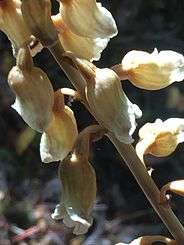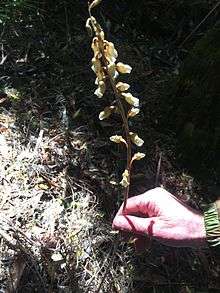Gastrodia sesamoides
| Potato orchid | |
|---|---|
 | |
| Ku-ring-gai Chase National Park, Australia | |
| Scientific classification | |
| Kingdom: | Plantae |
| (unranked): | Angiosperms |
| (unranked): | Monocots |
| Order: | Asparagales |
| Family: | Orchidaceae |
| Subfamily: | Epidendroideae |
| Genus: | Gastrodia |
| Species: | G. sesamoides |
| Binomial name | |
| Gastrodia sesamoides | |
Gastrodia sesamoides is a saprophyte in the orchid family. Common names include potato orchid, native potato, bell orchid and cinnamon bells.
The potato orchid is found in Australia and New Zealand. This leafless plant occurs in a variety of habitats; often growing in leaf litter in high rainfall areas. Indigenous Australians have been known to eat the tubers,[1] hence the potato reference in the common name. Aboriginal peoples located the plants in habitat by observing where bandicoots had scratched in search of the tubers after detecting the plants underground by scent.[2] The flavour of the tuber is said to resemble that of the beetroot, though insipid and watery.[3] Within the tubers are beneficial bacteria and fungi. The fungal filaments supply soil nutrients to the plant and the root bacteria synthesizes nitrogen for the plant.[4] The root tubers may grow to 15 cm (6 in) long and 4 cm (1.5 in) thick.
The original specimen was collected at Sydney in 1803.[5] But now it is considered rare or extinct near Sydney.[4] Flowering occurs between August and January, on a raceme. The flowers are self-pollinating and produce an appealing cinnamon-like scent. The flowers are somewhat unusual, as the sepals and petals are fused into a tube. Stems are between 30 and 60 cm (12 and 23.5 in) tall.[6]
A difficult plant to grow in cultivation. The fungal and bacterial agents need to be present, and root disturbance is often fatal. Fungicides and fertilizers are to be avoided. A sheltered humus rich situation is preferred. Propagation from seed is not easy, and the collection of seeds in the wild is often illegal.[3][7]
The specific epithet sesamoides refers to a supposed similarity to the sesame plant.[4] This species first appeared in scientific literature in the year 1810, in the Prodromus Florae Novae Hollandiae, authored by the prolific Scottish botanist Robert Brown.[5]
Description

G.sesamoides has a robust spike with crowded tubular flowers on a leafless stem which is up to 1m tall with 20 or more flowers on it. This plant is saprophytic, generally with a brown coloured stem. It is also called ‘potato orchid’ due to its color and flower stems arising from a large underground tuber which also gives rise to the common name. It often occurs in loose colonies but is rarely observed in close. Each flower has petals and sepals and labellum in small white or cream fan at the end of a pale brown tube. Leaves are absent. The stem is slender to moderately robust but sometimes up to 1 m in height, pale to brown arising from an underground rhizome. The flowers range from only a few to numerous, are brown and white to 2 or more cm long and have a osweet spicy fragrance similar to cinnamon so it is commonly called "cinnamon bells". It can grow in a range of soil types but as it is a saprophyte is wholly dependent on the presence of soil myccorhiza for its survival.
Habitat [9]
Gastrodia sesamoides is a saprophytic plant which is generally found in place like open situations, wet sclerophyll forests and dry sclerophyll forest, dry sclerophll woodlands, riparian areas and in leaf litter under snow gums and intermediate and high altitudes. Usually it’s observed in shady, well forested places in higher rainfall areas having more than 8oo mm rainfall per year, chiefly near decaying tree stumps, especially along creeks where large clumps of plants may appear in good seasons. Also recorded in areas where pine plantation are present, coastal sand-hill and heath. This plants are saprophytic. Its root are present all year and mainly occurs during summer season and flowering starts during early summer. G.sesmoides is world’s tallest orchid but smaller plant with slender stem and possess very few number of flower. The top part of the steam is very unique and distinctively bent when the plant is in budding stage.
Distribution [10]
G.sesamoides is represented by about 35 species in which 7 are endemic in Australia other occurs in India, QLD, New Zealand, NSW, New Guinea, ACT, VIC, TAS and NZ. In South Australia, also occurs in MU, KI and SE regions. Considered uncommon in South Australia. The distinguishing character of this new entity is that it forms localized clonal groups with the flowering stems connected in a network of irregular subterranean rhizomes. This species can be also found in wet sclerophyll forest and mixed rain-forest.
Uses

Underground rhizoids are rich in starch so it was used as food source by many indigenous Australian aboriginal people and it was important [art of their diet. Many people in other part of world like in Asian countries people use it in for making tea and herbal soup for getting health benefits. In India it is widely used in worshiping god and in decoration in marriage ceremonies. Its conservation status is very unique and highly restricted. It is also used in manufacturing perfumes for ladies, soaps for babies and many other application are there in regards to usage of its fragrances. Many herbal and Ayurveda medicines are prepared out of this species in India and also utilized in tea preparation. Many people in Australia and world around use this species as beautiful enhancing decorative plant in their houses and gardens. The root nodules in rhizoids of this plant help to fix nitrogen.Its root - raw or cooked. It resembles a beetroot in flavor but is watery and insipid.
References
- ↑ "Potato Orchid". Plant Use. Australian National Botanic Gardens. Retrieved 11 October 2011.
- ↑ Early western district (Vic.) settler gives account of local Aboriginal people gathering Potato Orchid tubers, digging where bandicoots had scratched. (Dawson in Zola & Gott, 1992:38)
- 1 2 "Potato Orchid". Aussie Gardening. Archived from the original on 30 December 2012. Retrieved 11 October 2011.
- 1 2 3 Les Robinson – Field Guide to the Native Plants of Sydney, ISBN 978-0-7318-1211-0 page 248
- 1 2 "Gastrodia sesamoides R.Br". Australian Plant Name Index (APNI), IBIS database. Centre for Plant Biodiversity Research, Australian Government.
- ↑ Fairley, Alan; Moore, Philip (2000). Native Plants of the Sydney District:An Identification Guide (2nd ed.). Kenthurst, NSW: Kangaroo Press. p. 390. ISBN 0-7318-1031-7.
- ↑ "Gastrodia sesamoides". Plants for a Future. Retrieved 29 September 2011.
- ↑ "Anon, (2017). 1st ed" (PDF).
- ↑ "Anon, (2017). 1st ed".
- ↑ "Anon, (2017). 1st ed".
| Wikimedia Commons has media related to Gastrodia sesamoides. |
| Wikispecies has information related to Gastrodia sesamoides |